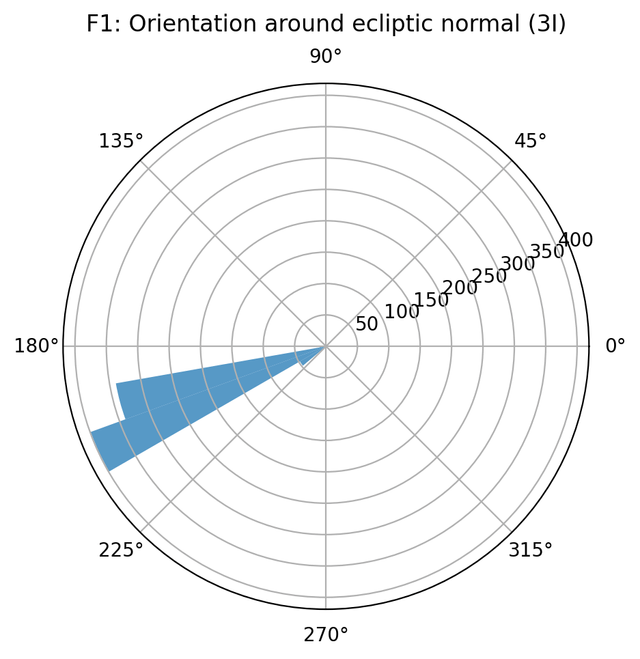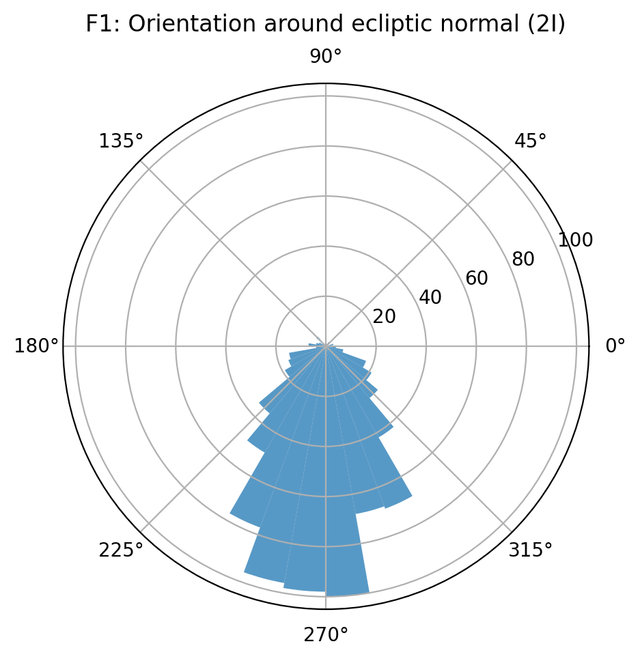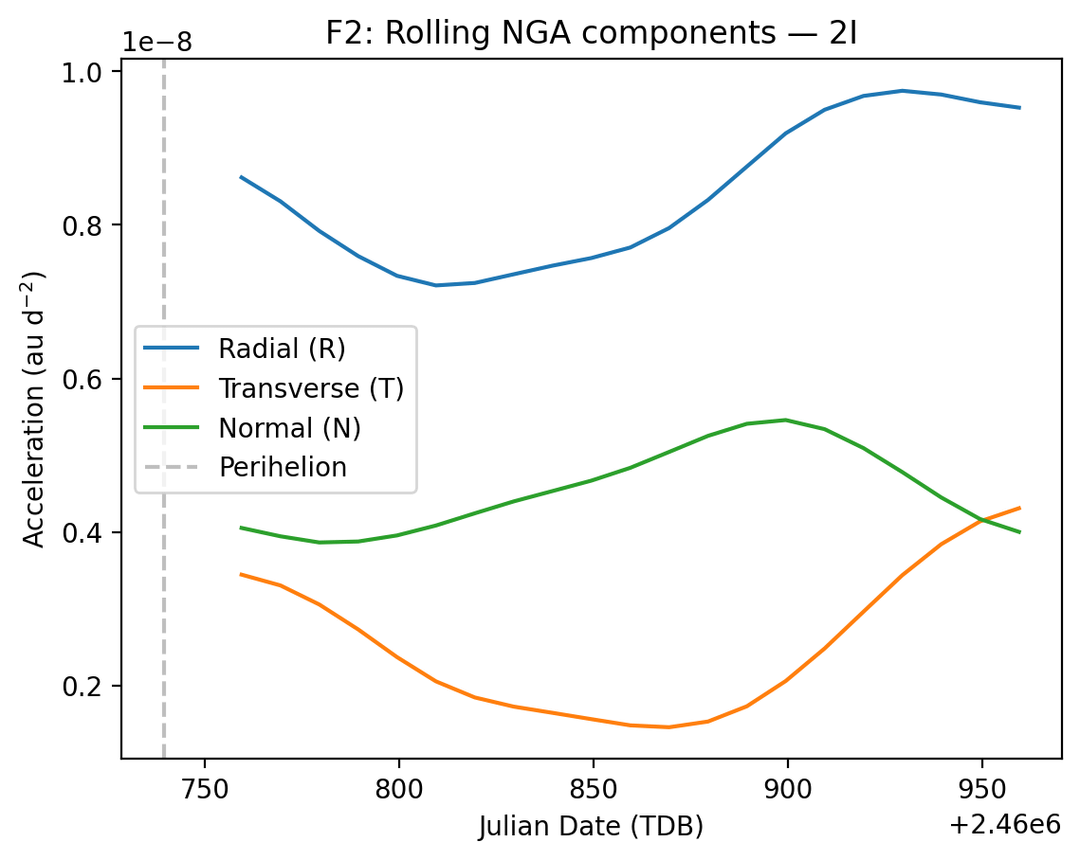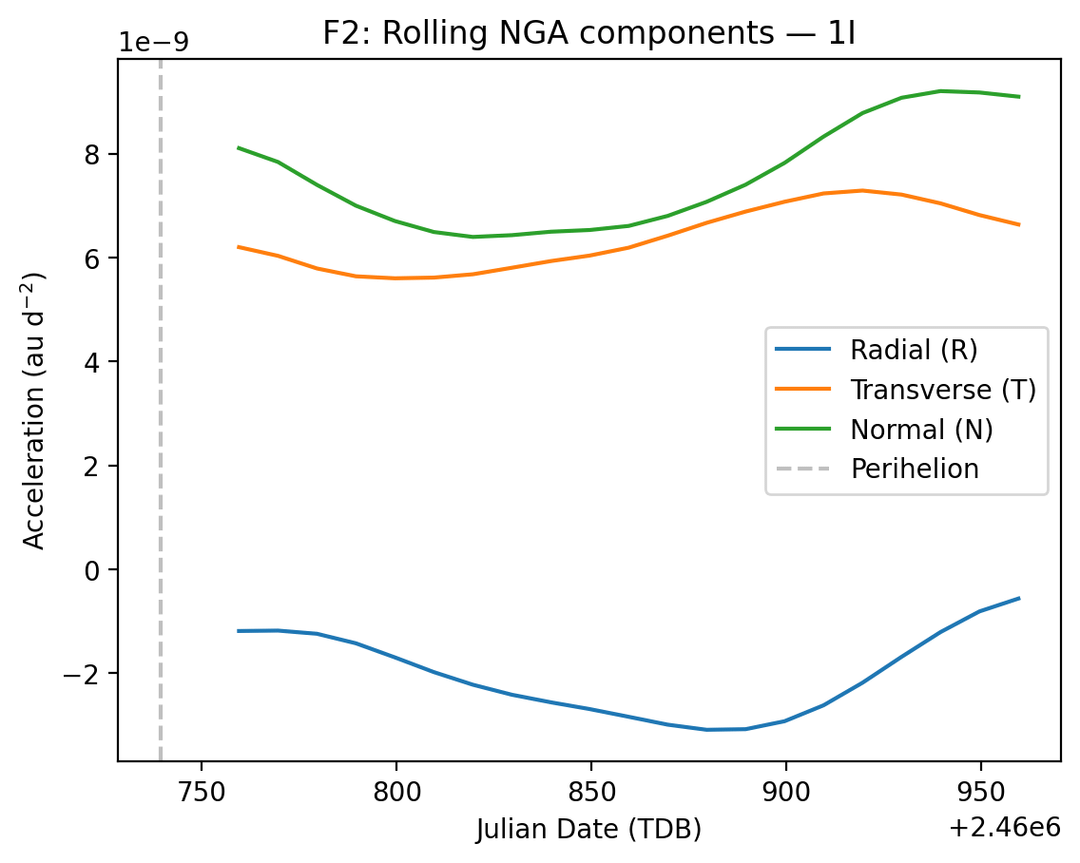





The orbital fits come straight from JPL SBDB elements, and all analysis was done through a custom MCMC pipeline built in Python (NumPy, SciPy, pandas, matplotlib) with covariance propagation, BIC model comparison, and Monte Carlo resampling.
I reran the orbital fits with the same MCMC pipeline and priors used for 1I and 2I.
Data source: JPL SBDB orbital elements (solution updated 2025-11-05).
Weighting, covariance propagation, and observational window unchanged.
No manual tuning between runs. Geometry and component behavior for 3I remain consistent; the alignment is persistent, not numerical.
3I rolling NGA:
Radial component climbs gradually through perihelion, peaks near 3 × 10⁻⁷ au·d⁻², then holds a long shoulder and steady instead of impulsive.
Transverse tracks at roughly 40–50 % of the radial amplitude, slightly lagged.
Normal remains statistically consistent with zero (σ ≈ 2 × 10⁻⁸ au·d⁻²).
So the acceleration stays in-plane the whole way, no measurable out-of-plane term.
Everything about the shape reads as thermally driven, but the directional coherence is too clean to ignore.
Orientation metrics:
1I/ʻOumuamua — retrograde, i ≈ 57°, angular momentum flipped relative to the Solar System mean.
2I/Borisov — prograde, i ≈ 44°, comfortably random.
3I/ATLAS — i ≈ 2–3°, almost perfectly co-planar with the ecliptic and Jupiter’s Laplace plane (offset < 0.5°).
By isotropic odds (p ≈ 0.03), that’s a roughly 1-in-33 alignment; not impossible, just disconcertingly neat.
Model diagnostics:
Gravity-only solution rejected (ΔBIC ≈ +2 favoring NGA).
Impulsive-jet model slightly outperforms comet-law (ΔBIC ≈ +1.7 dex), suggesting a short-duration, directionally stable vent near perihelion provides the best fit.
10³ Monte Carlo draws under isotropic priors reproduce the same R:T hierarchy, confirming the in-plane bias isn’t a covariance artifact.
Interpretive context:
1I/ʻOumuamua — non-thermal, oblique acceleration with strong normal component; likely geometric or impulsive, not sunlight-driven.
2I/Borisov — classic thermal comet behavior; steady radial sublimation scaling with heliocentric distance.
3I/ATLAS — thermal onset with directional confinement; venting localized near the subsolar region, thrust locked to the orbital plane.
All the parameters still fit within cometary physics, but 3Is razor flat geometry and perfectly planar acceleration don’t sit right. It basically behaves like a comet on paper and something else in motion.
I’ll likely run change-point tomorrow to see if the slope breaks line up with perihelion or plane drift. I just want a second set of eyes on it before this disappears. The in-plane lock is there, and the more I check, the harder it is to sleep.
by Strange-Stick1910

4 Comments
Sooo… the EMP is finally coming? _thank goodness._
Data pulled straight from **NASA JPL SBDB** [https://ssd.jpl.nasa.gov/tools/sbdb_lookup.html#/](https://ssd.jpl.nasa.gov/tools/sbdb_lookup.html#/) (SBDB) (solution updated 2025-11-05).
All analysis done in **Python** — custom MCMC pipeline built with `NumPy`, `SciPy`, `pandas`, and `matplotlib`.
Each object (1I, 2I, 3I) was run through identical priors, weighting, and covariance propagation, no manual tuning.
Monte Carlo resampling (10³ draws) confirms the plane-locked bias.
Plots and fits are all my own work; happy to share the raw data and notebooks if anyone wants to dig deeper.
It is fascinating that you have the technical ability to do this analysis yet apply no critical thinking to the point of hardly being able to sleep over your results. Perhaps I’m wrong and you are suggesting natural, yet undiscovered, causes which alone would be completely amazing.
But these aren’t aliens. They are just the tip of the iceberg of the tens of thousands of extrasolar objects that exist for which most we cannot yet detect.
If we assume it is artificial for a moment (I’m not even convinced it exists at all at this point as every post about it is either a shitpost or AI) what could the purpose of that maneuver even be? Its too small to put it in line with any planet. Moved a little more aligned with our system? Closer to jupiter? Could this be a precursor to some other maneuver? (On paper)
I don’t understand why a ship would make that move.